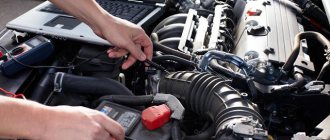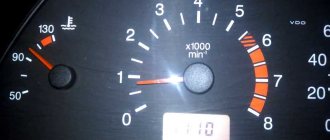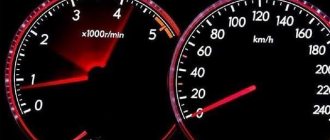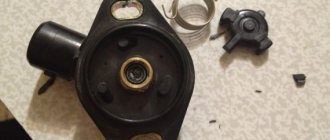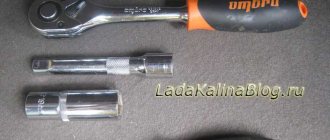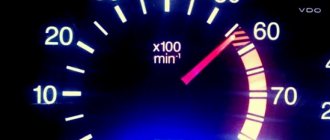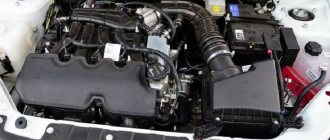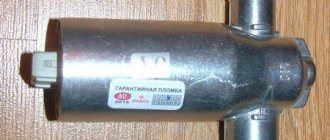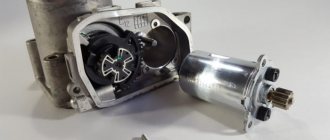When it comes to factors that affect the resource and durability of a motor, driving style is often mentioned. It also affects the resource of other elements and systems.
Because of this, many motorists have a natural desire to adhere to the safest and most correct conditions for operating vehicles. This will protect the car from premature wear, breakdowns and rapid consumption of the internal combustion engine.
The question remains open regarding what is considered a correct and gentle regime. Driving style has a lot to do with how the driver uses engine speed. Here it is important to understand how to properly manage them, and what will happen if you always keep the tachometer only in the zone of high or low speeds.
Optimal engine speed when operating a car
The operating mode of the engine is one of the main factors influencing the wear rate of its parts. It’s good when the car is equipped with an automatic transmission or a variator, which independently selects the moment of transition to a higher or lower gear. On cars with “mechanics”, switching is done by the driver, who “spins” the engine according to his own understanding and not always correctly. Therefore, car enthusiasts without experience should study what speeds are best to drive at in order to maximize the life of the power unit.
Walking is prohibited: what is idle speed and what does it depend on?
How it all began
On the first engines, even the very concept of idle speed did not exist.
The operating and idle speeds were almost identical, and the engine operating range was extremely small (approximately only from 250 to 450 rpm). Well, where to go: you can’t go lower, it won’t spin higher... Wick carburetors had a very small operating range and, at low flows, the mixture “overflowed” a lot. In fact, they were adjusted only to operating speeds. The situation changed around 1915. The appearance of a real carburetor with jets and ignition timing control on the Packard Twin Six solved two problems. Firstly, significantly increase power by increasing operating speed to 3000 per minute, and secondly, reduce stable speed by introducing a special mixture formation system at low speeds. In other words, idle systems.
Under the hood of the Packard Twin Six Town Car '1916
All later carburetor designs already provided for adjustment and adjustment of mixture formation at idle speed, often using separate metering systems for this mode. Of course, the environment and even the resource for those designs were not the determining factors, but the engines simply could not operate at speeds lower than those at which the carburetor could create a mixture. But then the system became much more complex.
Why do you need idle speed?
While the engine is turned off, it, of course, does not create any torque. But even when the engine is running, power grows exclusively with increasing revolutions, and torque peaks in the region of medium or high speeds (on supercharged engines torque appears earlier, but also far from zero).
To load the motor with a payload, it must already be spinning steadily and ready to produce torque. Otherwise it will simply stall. Sorry that it’s so difficult to explain a simple thing, but this is an extremely important point for further understanding.
You can load the internal combustion engine only if it is already running at a stable speed that is sufficient to absorb the load. There are no ways to bypass this limitation. You can only avoid this problem by using an additional engine, which will work instead of the internal combustion engine until the operating speed is reached. For example, this function is performed by an electric motor on hybrids or a pneumatic starter with excess power.
Those speeds at which the motor can take the load are called idle.
All speeds above idle are working. Below begins the zone of starting speeds, at which the engine cannot bear the load for one reason or another. For most passenger car engines, the idle speed is 500-900 rpm, which is not so low. If you use an automatic transmission, you can “cheat” a little and set the idle speed without load on the transmission side lower, increasing it only when you turn on the “Drive” mode in the box.
Why is the idle speed not constant?
With different power systems, the reasons for changes in idle speed are different. On internal combustion engines with simple unregulated carburetors, the speed depends on the load and mixture formation. If automatic speed boosters are triggered, then as the load increases, the speed will drop. The same thing will happen due to poor mixture formation, but they try to avoid this by using various cold start systems that increase the speed to ensure stable engine operation.
The more perfect the power system, the less noticeable the fluctuations. With a simple carburetor, the driver controls the idle speed himself. Its intervention is required if the engine temperature or load on it differs from those set when adjusting the idle speed. With an electronic carburetor with a cold start automatic, the driver no longer adjusts anything, but the speed increases noticeably to ensure stable operation until it warms up.
Under the hood of the VAZ-2107 Zhiguli '1997–2006
Injection systems will only allow you to slightly increase the idle speed until the lambda sensors warm up and keep them slightly elevated until the mixture formation is normalized by 100-1000 rpm. And they can also increase the speed slightly when the load from the air conditioning system or the load from the generator increases. In all other cases, a working system should maintain speed almost constant, within +/- 30 rpm.
Articles / Practice What is more important for acceleration – power or torque? This question is one of the main topics of “holivars” on automobile forums. Opponents are ready to tear each other apart, citing dozens of arguments. But everything is simple: power is mome... 371791 6 71 02/02/2015
Unfortunately, all regulatory methods are not ideal. XX regulators and electrically driven throttle valves become dirty over time, not all spark plugs and injectors work perfectly, EGR systems leak gases, phase control systems fail, and the cylinders may have different compression, which is why in real life on older cars the revs still fluctuate a little ": they sag excessively under load or, conversely, become too high.
Why is the idle speed the way it is?
Choosing idle speed is always a compromise. Increasing them means increasing fuel consumption and heat dissipation of the engine without load, which is obviously a bad idea and is not suitable for a civilian vehicle. A decrease leads to several unpleasant consequences at once.
Firstly, mixture formation is disrupted. The processes in an internal combustion engine are dynamic, and its entire design is designed for operating speeds. As the rotation speed decreases, the cleaning of the cylinders from exhaust gases worsens, filling the cylinders with fresh mixture becomes more difficult, bypass losses increase, and therefore power decreases.
Maybe such an understatement of XX will make the engine at least more environmentally friendly? Also no. Quite the contrary. Even if the engine retains the ability to perceive load at speeds less than idle, its operating process will be far from the calculated one. For example, at speeds less than 400-500, often even the catalytic collectors stop warming up to operating temperature, and the number of misfires increases.
A serious problem is a decrease in oil pressure and volume of oil supply. Everything is simple here: lower speed - lower pressure. At a certain minimum pressure, the sliding bearings leave the fluid friction mode, and the life of the motor rapidly decreases. And the higher the load, the higher the pressure should be, and therefore the engine speed.
Articles / Practice Long-stroke and short-stroke motors - what is the difference and which is better? Admit that you have often seen phrases in test drives about “the typically short-stroke nature of the engine” and did not quite understand what they were talking about. Today we will finally tell you what short and long… 89757 6 28 12/15/2016
The load on the engine even at idle speed can be significant (especially with a manual transmission). Automatic transmissions can prevent troubles, but they do not completely solve problems, although they significantly increase the life of the internal combustion engine as a whole. As a result, the oil pressure at idle speed should already be sufficient to absorb the full load on the engine. Unfortunately, the higher the pressure and performance of the oil pump at idle speed, the greater the excess pressure on workers. This means more fuel consumption, less oil life. An adjustable oil pump improves the situation slightly, but mainly still serves to compensate for the excessive drop in oil pressure after the engine warms up, and not to reduce idle speed.
On cars with an automatic transmission, its “wishes” must also be taken into account. After all, the automatic transmission oil pump is driven from the engine crankshaft, which means the operation of the gearbox depends on the idle speed. If the speed is too low, the pressure will not be enough for the correct operation of the mechanical-hydraulic control system. And for start-stop systems it is necessary to install hydraulic accumulators and additional electric pumps. This allows the hydraulics to start working immediately when the engine starts, and not after five to ten seconds.
The drive of various attachments also creates difficulties. The generator, power steering and air conditioning pumps and the cooling system pump have a limited operating range, so the gear ratio of the drive system of additional units is selected taking into account the maximum engine speed. And the minimum speed of any of the devices and the load on the machine subsystems limit the lower idle speed. Too much reduction in speed can lead to overheating of multi-cylinder engines due to impaired fluid circulation, battery discharge or inoperability of the air conditioning system. True, these problems can also be solved.
Here, switching to electric drives for the power steering, cooling system and air conditioning pumps and installing an adjustable pump drive will help out. Fortunately, generators have a very large operating range and do not lose efficiency at high speeds. But these measures also have disadvantages. They often entail unnecessary costs, and often a decrease in the efficiency of systems due to double energy conversion.
Engine vibration when the speed decreases is mainly associated with instability of the work process, but it also has several other reasons. For example, the suspension system of an internal combustion engine can dampen vibrations only in a certain frequency range. And the lower the speed, the more difficult it is to dampen the resulting vibrations. Moreover, in addition to vibrations transmitted to the body and affecting the comfort of the driver and passengers, there is also such a thing as torsional vibrations, which have a destructive effect on the transmission and wheels.
The lower the engine speed, the more difficult it is to extinguish them. You have to either use non-locking torque converters or dual-mass flywheels, or a combination of two technologies at the same time. Increasing the idle speed allows you to reduce torque fluctuations at each revolution, move the frequencies of all vibrations further from resonant ones and make the operation of all vibration suppression systems more efficient.
Driving at low speeds with early shifting
Often, driving school instructors and old drivers recommend that beginners drive “tight” - switch to higher gear when the crankshaft reaches 1500–2000 rpm. The former give advice for safety reasons, the latter out of habit, because previously the cars had low-speed engines. Nowadays, such a mode is only suitable for a diesel engine, whose maximum torque is in a wider speed range than that of a gasoline engine.
Not all cars are equipped with tachometers, so inexperienced drivers with this driving style should be guided by driving speed. The early switching mode looks like this: 1st gear - moving from a standstill, transition to II - 10 km/h, III - 30 km/h, IV - 40 km/h, V - 50 km/h.
Such a switching algorithm is a sign of a very calm driving style, which gives an undoubted advantage in safety. The downside is the increased wear rate of power unit parts and here’s why:
Owners of cars equipped with an on-board computer can easily convince themselves of the uneconomical nature of driving under tension. It is enough to turn on the display to show instantaneous fuel consumption.
This type of driving greatly wears out the power unit when the car is operated in difficult conditions - on dirt and country roads, with a full load or a trailer. Owners of cars with powerful engines of 3 liters or more, capable of sharp acceleration from the bottom, should not relax either. After all, to intensively lubricate the rubbing parts of the engine, you need to keep the crankshaft at least 2000 rpm.
Why is high crankshaft rotation speed harmful?
The “slipper to the floor” driving style implies constant spinning of the crankshaft up to 5–8 thousand revolutions per minute and late shifting of gears, when the noise of the engine literally rings in your ears. What are the consequences of this driving style, besides creating emergency situations on the road:
Running a car “to break” has an additional negative effect associated with the quality of the road surface. Driving at high speed on uneven roads literally kills suspension elements, and in the shortest possible time. It is enough to fly your wheel into a deep pothole and the front strut will bend or crack.
The general technical condition of the car, including its engine, cooling system, transmission and much more, can always be checked using a personal ODB-II auto scanner. One of the best representatives of this type of device is the Korean-made scanner Scan Tool Pro Black Edition.
How to ride correctly?
If you are not a race car driver or a fan of hard driving, who find it difficult to relearn and change your driving style, then to save the power unit and the car as a whole, try to keep the engine operating speed in the range of 2000–4500 rpm. What bonuses will you receive:
Recommendation. On most modern cars equipped with high-speed gasoline engines, it is better to change gears when the threshold of 3000 ± 200 rpm is reached. This also applies to the transition from high to low speed.
As mentioned above, car dashboards do not always have tachometers. For drivers with little driving experience, this is a problem, since the crankshaft rotation speed is unknown, and a beginner cannot navigate by sound. There are 2 options for solving the issue: buy and install an electronic tachometer on the dashboard, or use a table that shows the optimal engine speed in relation to the speed in different gears.
| 5-speed gearbox position | 1 | 2 | 3 | 4 | 5 |
| Optimal crankshaft rotation speed, rpm | 3200–4000 | 3500–4000 | not less than 3000 | > 2700 | > 2500 |
| Approximate vehicle speed, km/h | 0–20 | 20–40 | 40–70 | 70–90 | more than 90 |
Note. Considering that different brands and modifications of cars have different speeds and revolutions, the table shows average indicators.
A few words about coasting down a mountain or after acceleration. Any fuel supply system has a forced idle mode, which is activated under certain conditions: the car is coasting, one of the gears is engaged, and the crankshaft speed does not fall below 1700 rpm. When the mode is activated, the supply of gasoline to the cylinders is blocked. So you can safely brake the engine at high speed without fear of wasting fuel.
Source
Idle speed control
The first thing you should check is the idle speed control. To do this, you will need a tester (multimeter) set to ohmmeter mode.
The check is performed as follows:
- turn off the ignition;
- disconnect the block;
- measure the resistance between contacts A * B and C * D of the regulator. If it is working properly, the device will show a resistance value in the range from 40 to 80 Ohms;
- measure the resistance between contacts B * C and A * D. If the regulator is operational, the ohmmeter will go off scale (on some devices an “open circuit” may be indicated).
Dirty IAC VAZ 2114
If the results obtained during measurements differ from those given above, then the idle speed controller is broken. By the way, its failure is one of the most common reasons why the idle speed of a VAZ 2114 injector fluctuates. If a breakdown is detected, the part should be replaced with a new, similar one (since the IAC is not a repairable device). Do not forget that before starting to replace the device, you should disconnect the battery ground terminal.
What engine speed should you keep?
Almost every driver is well aware that the life of the engine and other components of the car directly depends on the individual driving style. For this reason, many car owners, especially beginners, often think about what speed is best to drive at. Next, we will look at what engine speed should be maintained, taking into account different road conditions during vehicle operation.
Engine life and speed when driving
Let's start with the fact that competent operation and constant maintenance of optimal engine speeds allows you to achieve an increase in engine life. In other words, there are operating modes when the motor wears out the least. As already mentioned, the service life of the internal combustion engine depends on the driving style, that is, the driver himself can conditionally “adjust” this parameter. Please note that this topic is the subject of discussion and debate. More specifically, drivers are divided into three main groups:
Driving at low speeds
Let's take a closer look. Let's start with driving at the "bottoms". This mode means that the driver does not raise the crankshaft speed above 2.5 thousand rpm. on gasoline engines and holds about 1100-1200 rpm. on diesel. This driving style has been imposed on many since driving school. Instructors authoritatively assert that it is necessary to drive at the lowest speeds, since in this mode the greatest fuel economy is achieved, the engine is least loaded, etc.
VAZ 2114 engine modifications
Over the ten years of serial production of the VAZ 2114, the following was installed on it:
- 1.5i . Engine VAZ 2114 with a volume of 1.5 liters, with 8 valves. Its maximum power was 78 hp. C. at 5800 rpm. Torque at 3800 rpm reaches 116 N.m. Per 100 km in the mixed cycle, gasoline consumption is 7.3 liters. In this modification of the internal combustion engine, an injection intake with control through the electronics was used, instead of the outdated carburetor, and a new camshaft with corrected phases was installed. Thanks to the introduction of an injector into the VAZ 2114 engine, engineers were able to increase the efficiency of the engine, increasing its power, and at the same time reducing fuel consumption. This was a big starting step in the development of the entire range of internal combustion engines of the Volzhsky Automobile Plant.
- 1.6i . In 2004, a modification of the engine was released with an increased volume of 1.6 liters. It developed a power of 81 hp. With. at 5200 rpm and 125 N.m. at 3000 rpm. In the combined cycle, the engine consumes 7.6 liters of gasoline per 100 km. The VAZ 2114 engine with an injector and 8 valves received an increased volume due to the cylinder height increased by 2.3 mm, which made it possible to make a larger piston stroke. The ignition module was replaced by a coil. The internal combustion engine turned out to be more powerful and environmentally friendly, but fuel consumption increased compared to the previous model.
- 16V 1.6і (124) . Also in 2004, a 1.6-liter engine was released, but with 16 valves, that is, 4 for each cylinder. This engine already had 89 horsepower at the flywheel at 5000 rpm and 131 Nm of torque at 3700 rpm. The plant claims consumption in the combined cycle of 7.5 liters per 100 km. The VAZ 2114 8-valve engine with an injector received modifications in the form of an increase in the number of valves to 16 pieces. The rest of the characteristics remain the same. The car began to meet EURO-3 environmental requirements, gained an additional 8 horsepower and became a little more economical.
- 16V 1.6і (126) . In 2007, this engine was greatly modified, the volume remained the same 1.6 liters, but the power already reached 98 hp. With. at a speed of 5600 per minute, and the torque develops 145 N.m. at 4000 rpm. Fuel consumption was reduced to 7.2 liters per 100 km.
They worked hard on the old VAZ 2114 engine for 3 years and made several changes:
- the connecting rod and piston group is lightened by 39%;
- The timing drive has been changed, it has become automatically tensioned;
- valve holes have decreased in size;
- The quality of cylinder honing has improved significantly.
